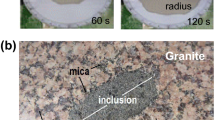Abstract
This paper presents the results of an experimental investigation on the cracking behavior of brittle heterogeneous materials. Unconfined, uniaxial compression tests were conducted on prismatic gypsum specimens containing either one, or two, inclusions. These inclusions were of different strengths, stiffnesses shapes, and sizes. Emphasis was placed on crack coalescence processes associated with specimens containing an inclusion pair, as this was the primary objective of the research. Some observations reported in this study compare well with those of other researchers as the overall cracking sequences are similar. On the other hand, the amount of debonding observed in this study at the inclusion interface is significantly less than what was previously observed. Moreover, the extent of shear crack growth at an inclusion boundary increased substantially in specimens containing two inclusions, compared to those with single inclusions.
Similar content being viewed by others
References
Aulia TB (2000) Strain localization and fracture energy of high-strength concrete under uniaxial compression. LACER 5: 221–240
Baecher GB, Einstein HH (1981) Size effect in rock testing. Geophys Res Lett 8(7): 671–674
Bienawski ZT (1967) Mechanisms of brittle fracture of rock, part II—experimental studies. Int J Rock Mech Min Sci 4: 407–423
Bobet A, Einstein HH (1998) Fracture coalescence in rock-type materials under uniaxial and biaxial compression. Int J Rock Mech Min Sci 35(7): 863–888
Bombolakis EG (1963) Photoelastic stress analysis of crack propagation within a compressive stress field. Ph.D. thesis, Massachusetts Institute of Technology, Cambridge, 106 p
Brace WF, Bombolakis EG (1963) A note on brittle crack growth in compression. J Geophys Res 68(12): 3709–3713
Eidelman A, Reches Z (1992) Fractured pebbles—a new stress indicator. Geology 20: 307–310
Goodier JN (1933) Concentration of stress around spherical and cylindrical inclusions and flaws. J Appl Mech 1: 39–44
Griffith AA (1920) The phenomenon of rupture and flow in solids. Phil Trans A 221: 163–198
Hansen TC (1958) Creep of concrete. Swed Cem Conc Res Inst 33: 48
Hoek E, Bieniawski ZT (1965) Brittle fracture propagation in rock under compression. Int J Frac Mech 1: 137–155
Horii H, Nemat-Nasser S (1985) Brittle failure in compression: splitting, faulting, and brittle-ductile transition. Phil Trans A319: 337–374
Inglis CE (1913) Stresses in a plate due to the presence of cracks and sharp corners. Inst Naval Arch 55: 219–230
Irwin GR (1957) Analysis of stresses and strains near the end of a crack traversing a plate. J of App Mech 24: 361–364
Kirsch G (1898) Die Theorie der Elastizität und die Bedürfnisse der Festigkeitslehre. Zeitschrift des Vereines Deutscher Ingenieure 42: 797–802
Ko TY, Einstein HH, Kemeny J (2006) Crack coalescence in brittle material under cyclic loading. In: Proceedings of 41st US symposium on rock mechanics (USRMS). Goldsen, Colorado, ARMA/USRMS 06-930
Kupfer H, Hilsdorf HK, Rusch H (1969) Behavior of concrete under biaxial stresses. ACI J Proc 66(8): 656–666
Lo TY, Cui HZ (2004) Effect of porous lightweight aggregate on strength of concrete. Mat Lett 58: 916–919
Maji AK, Shah SP (1989) Application of acoustic emission and laser holography to study microfracture in concrete. In: Lew HS (eds) Nondestructive testing, ACI SP-112. American Concrete Institute, Detroit, MI, pp 83–109
Maji AK, Shah SP (1990) Mixed mode fracture in compression. In: Elfgren L, Shah SP (eds) Analysis of concrete structures by fracture mechanics. Chapman and Hall, New York, pp 55–68
Maji AK, Tasdemir MA, Shah SP (1991) Mixed mode crack propagation in quasi brittle material. Eng Frac Mech 38(2/3): 1058–1107
Mitsui K, Li Z, Lange DA, Shah SP (1994) Relationship between microstructure and mechanical properties of the paste-aggregate interface. ACI Mat J 91(1): 30–39
Nelson RA (1968) Modelling a jointed rock mass. MIT, M.Sc. thesis
Nesetova V, Lajtai EZ (1973) Fracture from compressive stress concentrations around elastic flaws. Int J Rock Mech Min Sci 10: 265–284
Neville AM (1997) Aggregate bond and modulus of elasticity of concrete. ACI Mat J 94(1): 71–74
Reyes O, Einstein HH (1991) Failure mechanism of fractured rock—a fracture coalescence model. In: Wittke W (ed) Proceedings of 7th international congress of rock mechanics. Aachen, Germany, pp 333–340
Shen B, Stephansson O, Einstein HH, Ghahreman B (1995) Coalescence of fractures under shear stress experiments. J Geophys Res 100(6): 5975–5990
Tasdemir MA, Maji AK, Shah SP (1989) Crack propagation in concrete under compression. J Eng Mech 116(5): 1058–1076
Taylor MA, Broms BB (1964) Shear bond strength between coarse aggregate and cement paste or mortar. Proc ACI J 61(8): 937–957
Wong LNY, Einstein HH (2009) Crack coalescence in molded gypsum and Carrara marble: part 2—microscopic observations and interpretation. Rock Mech and Rock Eng 42: 475–511
Wong LNY, Einstein HH (2009) Using high speed video imaging in the study of cracking processes in rock. Geo Test J 32(2): 164–180
Zaitsev YB, Wittmann FH (1981) Simulation of crack propagation and failure of concrete. Mat Struc 14(83): 357–365
Zhang MH, Gjørv OE (1990) Microstructure of the interfacial zone between lightweight aggregate and cement paste. Cem Conc Res 20(4): 610–618
Author information
Authors and Affiliations
Corresponding author
Rights and permissions
About this article
Cite this article
Janeiro, R.P., Einstein, H.H. Experimental study of the cracking behavior of specimens containing inclusions (under uniaxial compression). Int J Fract 164, 83–102 (2010). https://doi.org/10.1007/s10704-010-9457-x
Received:
Accepted:
Published:
Issue Date:
DOI: https://doi.org/10.1007/s10704-010-9457-x




